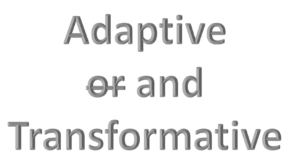This is one of the questions futurists wrestle with periodically. What is our proper purpose? Should we be helping our clients (defining clients broadly from paid project work to voluntary work on behalf of planet earth and its people)? Some would argue it should be one or the other. Typically, the “strong” position is that we should only work on transformative futures. But I’d like to propose that we acknowledge that both are useful. In some cases, we aim and work at transformation. In others, we aim and work at adaptation.
project work to voluntary work on behalf of planet earth and its people)? Some would argue it should be one or the other. Typically, the “strong” position is that we should only work on transformative futures. But I’d like to propose that we acknowledge that both are useful. In some cases, we aim and work at transformation. In others, we aim and work at adaptation.
The point came up in discussions around a potential project around impacts of climate change. Some of the discussion centered around what could be done to prevent certain future impacts – a transformative focus. And some centered around what could be done to prepare and respond to impacts that are very likely to happen. In the context of a project, where there are always constraints of time, budget, and people, there is often a choice to be made.
Another way to think of this is referring back to our trusty three horizons model.
- Think of an adaptive focus as being on Horizon Two (zone of transition)
- Think of a transformative focus as being on Horizon Three (new system)
Even when we have a primary focus on one horizon or the other, we are always paying attention to all three horizons. I suspect that futurists may develop their practice that tends to focus on one or the other. For me, I’d guess 80% of my project work has been on H2 adaptive. I am very happy that we have other futurists primarily focused on H3. But, let’s all repeat together (ha ha), we support a broad diversity in aims, approaches, methods, and techniques in foresight! – Andy Hines

One weakness of using the Three Horizons model for charting transitions to a Systemic Transformation is that it tacitly assumes continuous adaptive change from H1 to H3. It does not show discontinuities or systemic collapse between H2 & H3. The model visually seduces people into assuming a transformation will be a gradual process, which Transformations never are. Collapse & Transformation are two sides of the same coin. For a new system to supplant an existing one, the old one must Collapse when exposed to sufficient change. A systemic transformation functionally produces better adapted outputs to the core inputs. Collapses can be gradual, but only until they reach a critical limit which cannot be circumvented.. That is the transition point. Collapsing systems fail where Transforming systems succeed.